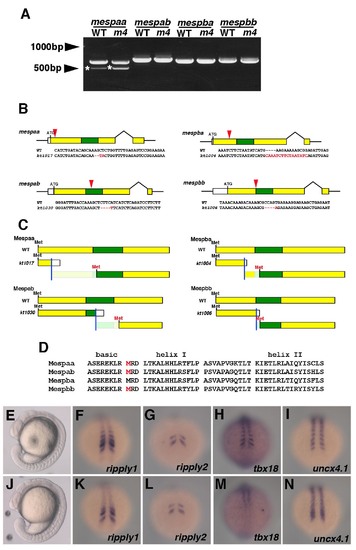Fig. S2
- ID
- ZDB-FIG-160908-9
- Publication
- Yabe et al., 2016 - Mesp quadruple zebrafish mutant reveals different roles of mesp genes in somite segmentation between mouse and zebrafish
- Other Figures
- All Figure Page
- Back to All Figure Page
|
Complete lack of Mesp function in the mesp quadruple mutant (A) RT-PCR products of mesp genes from the wild type and the mesp quadruple mutant embryo. Electrophoresis of mesps cDNA amplified by RT-PCR. The total RNA was isolated from wild type or mesp quadruple mutant embryos at the 8-somite stage. After reaction with reverse transcriptase, cDNA fragment containing the whole sequence of the coding region of th 4 mesps was amplified by PCR. All fragments were confirmed by direct sequencing and any unexpected splicing variant was not detected. Asterisks indicate non-specifically amplified PCR products, checked by direct sequencing. (B-F) Generation of mespabkt1030 and mespbbkt1006 allele. (B) Schematic diagrams showing mutations generated in the 4 mesp genes. Colored boxes indicate the coding regions; especially, green boxes show the basic helix-loop-helix domain. Red arrowheads indicate the approximate position of each mutation. Sequences around the mutation sites are also shown. Red characters in these sequences indicate mutated sequence. (C) Schematic diagrams of predicted protein structures produced from mesp mutant alleles shown in (B). Colored boxes indicate regions where amino acids in the same frame as the original could be translated and green boxes indicate the basic helix-loop-helix domain. White boxes indicate regions where different frames could be translated by frame-shift mutations. Blue lines indicate positions of the mutations. Possible coding frames containing the basic helix-loop-helix domain are also displayed. ?Met? colored with red indicate presumptive positions of the translational initiation site. (D) Amino acids sequences of the basic helix-loop-helix domain of the 4 Mesp proteins. Red-colored M correspond to the red-colored Met shown in (C). Note that the presumptive translation products from mutant alleles of mespaa, mespab, and maspbb could not contain the whole basic helix-loop-helix domain. (E,-N) Wild type (E, F, G,H,I) and another mesp quadruple mutant carrying distinct alleles from those mainly examined in this study (J,K,L,M,N). At the 16-somite stage, the morphology of mespaakt1017/kt1017; mespbakt1004/kt1004; mespabkt1030/kt1030; mespbbkt1006/kt1006 was obviously identical to that of mespaakt1017/kt1017; mespbakt1004/kt1004; mespabkt1002/kt1002; mespbbkt1009/kt1009, which were mainly examined in this study (E,F; See Figure 2). The expression ripply1, ripply2, tbx18 and uncx4.1 of mespaakt1017/kt1017; mespbakt1004/kt1004; mespabkt1030/kt1030; mespbbkt1006/kt1006 was also identical those of mespaakt1017/kt1017; mespbakt1004/kt1004; mespabkt1002/kt1002; mespbbkt1009/kt100 at the 11-somite stage (F-I, K-N; See Figure 3 and 5). |

